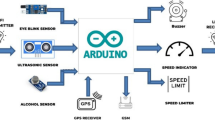Abstract
Globally, safety has become an increasingly important issue in the automotive industry. In an attempt to reduce traffic fatalities, UNECE launched a new EU Road Safety Program which aims to decrease the number of road deaths by half by 2020. AEB (Autonomous Emergency Braking) is a very effective active safety system intended to reduce fatalities. This study involves the design of a multi-sensor data fusion strategy and decision-making algorithm for AEB pedestrian. Possible collision avoidance scenarios according to the EuroNCAP protocol are analyzed and a robust pedestrian tracking strategy is proposed. The performance of the AEB system is enhanced by using a braking model to predict the collision avoidance time and by designing the system activation zone according to the relative speed and possible distance required to stop for pedestrians. The AEB activation threshold requires careful consideration. The test results confirm the advantages of the proposed algorithm, the performance of which is described in this paper.
Similar content being viewed by others
References
Chavez-Garcia, R. O., Burlet, J., Vu, T. D. and Aycard, O. (2012). Frontal object perception using radar and monovision. IEEE Intelligent Vehicle Symp., 159–164.
Cho, H. G., Seo, Y. W., Kumar, B. V. K. V. and Rajakumar, R. (2014). A multi-sensor fusion system for moving object detection and tracking in urban driving environments. Robotics and Automation (ICRA), IEEE Int. Conf., 1836–1843.
Eckert, A., Hohm, A. and Lueke, S. (2013). An integrated ADAS solution for pedestrian collision avoidance. Int. Technical Conf. Enhanced Safety of Vehicles (ESV).
EuroNCAP (2014). Euro NCAP 2020 Roadmap.
Gandhi, T. and Trivedi, M. M. (2007). Pedestrian protection systems: Issues, survey, and challenges. IEEE Trans. Intelligent Transportation Systems 8, 3, 413–430.
Hamdane, H., Serre, T., Masson, C. and Anderson, R. (2015). Issues and challenges for pedestrian active safety systems based on real world accidents. Accident Analysis & Prevention, 82, 53–60.
IRTAD (2016). International Traffic Safety Data and Analysis Group. Road Safety Annual Report 2016.
Keller, C. G., Dang, T., Fritz, H., Joos, A., Rabe, C. and Gavrila, D. M. (2011). Active pedestrian safety by automatic braking and evasive steering. IEEE Trans. Intelligent Transportation Systems 12, 4, 1292–1304.
KoROAD (2015). Road Traffic Safety Authority Korea. Traffic Accident Analysis.
Lee, D. H., Kim, S. K. and Huh, K. S. (2014). Development of an autonomous braking system using the predicted stopping distance. Int. J. Automotive Technology 15, 2, 341–346.
Laugier, C., Paromtchik, I. E., Perrollaz, M., Yong, M., Yoder, J., Tay, C., Mekhnacha, K. and Negre, A. (2011). Probabilistic analysis of dynamic scenes and collision risks assessment to improve driving safety. IEEE Intelligent Transportation Systems Magazine 3, 4, 4–19.
Moon, S., Moon, I. and Yi, K. (2009). Design, tuning and evaluation of a full-range adaptive cruise control system with collision avoidance. Control Engineering Practice 17, 4, 442–455.
Oikawa, S., Matsui, Y. and Sakurai, T. (2014). Characteristics of collision damage mitigation braking system for pedestrian protection. Int. J. Automotive Technology 15, 7, 1129–1136.
Seiniger, P., Bartels, O., Pastor, C. and Wisch, M. (2013). An open simulation approach to identify chances and limitations for vulnerable road user (VRU) active safety. Traffic Injury Prevention 14, Supplement 1, s2–s12.
Seiniger, P., Bartels, O., Kunert, M. and Schaller, T. (2014). Assessment Methodologies for Forward Looking Integrated Pedestrian and Further Extension to Cyclist Safety. IDIADA, ASPECSS D2.5.
Themann, P., Kotte, J., Raudszus, D. and Eckstein, L. (2015). Impact of positioning uncertainty of vulnerable road users on risk minimization in collision avoidance systems. IEEE Intelligent Vehicles Symp. IV), 1201–1206.
Tiemann, N., Branz, W. and Schramm, D. (2009). Predictive pedestrian protection-sensor requirements and risk assessment. Proc. Int. Technical Conf. Enhanced Safety Vehicles.
Wald, L. (1999). Some terms of reference in data fusion. IEEE Trans. Geoscience and Remote Sensing 37, 3, 1190–1193.
Westhofen, D., Grundler, C., Doll, K., Brunsmann, U. and Zecha, S. (2012). Transponder and camera-based advanced driver assistance system. IEEE Intelligent Vehicles Symp. IV), 293–298.
Wiest, J., Hö ffken, M., Kreßel, U. and Dietmayer, K. (2012). Probabilistic trajectory prediction with Gaussian mixture models. IEEE Intelligent Vehicles Symp. IV), 141–146.
WHO (2013). Pedestrian Safety: A Road Safety Manual for Decision-makers and Practitioners.
Author information
Authors and Affiliations
Corresponding author
Rights and permissions
About this article
Cite this article
Lee, HK., Shin, SG. & Kwon, DS. Design of emergency braking algorithm for pedestrian protection based on multi-sensor fusion. Int.J Automot. Technol. 18, 1067–1076 (2017). https://doi.org/10.1007/s12239-017-0104-7
Received:
Revised:
Accepted:
Published:
Issue Date:
DOI: https://doi.org/10.1007/s12239-017-0104-7




